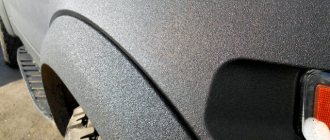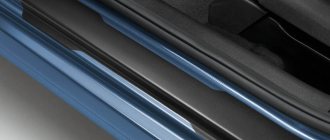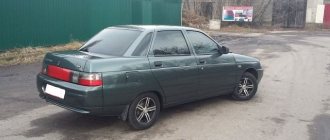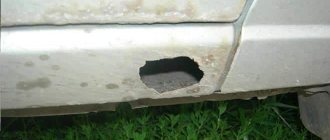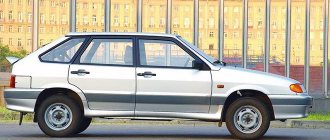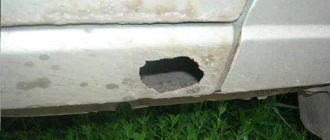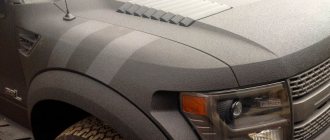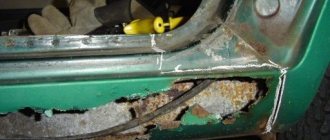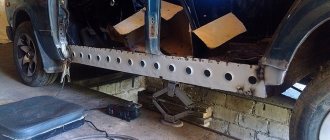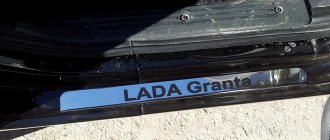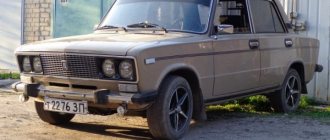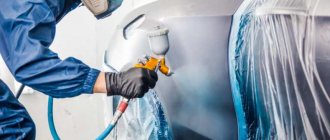It is advisable to paint car sills every year to avoid causing problems. You can do car door sill repair yourself. DIY painting technology is simple.
Why use anti-gravel coating
Anti-gravel is the general name for polymer or rubber-polymer compounds that are sprayed onto the external surfaces of the car. After application, anti-gravel creates a protective film on the thresholds with a thickness of 0.5 mm, which protects open body elements from damage by gravel, prevents reagents from reaching the metal, preventing corrosion of the thresholds.
Anti-gravel paint for car sills is a separate composition. After processing, a durable layer of protective film with a thickness of 0.1 mm remains on the surface. The paint does not ensure long-term preservation of the thresholds; the composition must be renewed every 3 months.
Causes of rust
Sills and arches are considered the most vulnerable parts of the body. Technologically, the parts provide protection of the bottom from primary corrosion. In addition, the sills prevent moisture from penetrating into the interior; in car frame structures they perform a strength function and provide the body with the necessary torsional rigidity.
The threshold is the first to absorb splashes, flying stones, and the aggressive effects of salt reagents in winter. There are several reasons why rust appears on a part.
- Microcracks in paintwork. Moisture and acids penetrate under the paint and destroy the metal from the inside.
- Lack of anti-corrosion protection. The production method of hot galvanizing remains the most reliable means of protecting metal from rust. Not all manufacturers use an expensive method. Volvo remains one of the few brands that galvanize the body of their cars in two or three layers; the first spots of corrosion on cars appear no earlier than after 9-12 years, provided that the metal was not destroyed in an accident.
- Untimely treatment of the threshold with anti-gravel.
- Systematic overnight stay of the car on the street in the rain and snow. Moisture destroys bare metal quite quickly. When producing a body, the manufacturer covers the metal with a protective polymer layer, which retains its properties for up to 1.5 years. If you do not monitor the condition of the body, then after the first winter on a new car you can see cracked paintwork and the beginning of rust.
Types of anti-gravel for car thresholds
Requirements for anti-gravel:
- Maintains elasticity in the temperature range -30+50.
- Optimal adhesion, adhesion to the surface.
- Contains zinc or any other corrosion inhibitors.
All brands presented in the rating meet these requirements, but when choosing protection, you must first check the condition of the body under a layer of paint. If there are significant pockets of corrosion, then it is better to use products that contain zinc and bitumen fillers. These elements preserve the hearth and will not allow the metal to deteriorate further.
Anti-gravel coating for the body is sold in cylinders or cans. The second option requires a construction gun or spray gun. Aerosols are convenient for treating thresholds, foam well, and leave an elastic layer of protective film. Canned packaging is cheaper and is more often used for anti-gravel treatment of large surfaces.
Hi-Gear (HG5760)
Anti-gravel Hi-Gear is considered the best among aerosol compositions. Its technical characteristics are close to “liquid rubber”; it is applied with fine grain. Forms a dense film on the surface of the threshold that does not lose elasticity for up to 1.5 years. The composition is transparent, often used as an armored film to protect headlights and mirror housings.
The cost of anti-gravel in a 500 ml cylinder is from 600 rubles, the capacity is enough for the complete treatment of thresholds, it is not practical to use it on the entire body due to the high cost. The range for treating thresholds includes a black composition. Complete drying occurs in 7 days.
Body 950
Body 950 spray is developed on a rubber base for application to sills and wheel arches; there are three colors of protective coating: white, gray, black. The material foams well, leaves a lumpy surface after drying, and protects body elements for up to 2 years.
The disadvantages of anti-gravel include high cost, the need to carefully prepare the surface: degrease and sand. The product has average adhesion to smooth surfaces; it is not recommended to apply it to unprimed metal.
Liqui Moly 6109
Aerosol anti-gravel Liqui Moly 6109 is available in a single black color. It is made of polyurethane resins, has good adhesion, and provides reliable protection of thresholds for up to 2 years. After treatment, it leaves an elastic film 0.1 mm thick and is not destroyed by acids and salts.
The main advantage is the ease of further painting of the thresholds due to the maximum smoothness of the top layer. The dried surface has maximum elasticity and resistance to reagents.
Novol Gravit MS 600
One of the best anti-gravel coatings that can be applied with a gun. The technology uses synthetic materials; it is also used for processing the bottom thanks to kilogram packaging. Novol anti-gravel is produced in white, black and gray, which allows you to quickly select the color of paintwork.
The composition dries in 24 hours, forms a durable film, and has high sound insulation properties when applied to the bottom. Anti-gravel is compatible with all acrylic paints and varnishes.
Body 930
Anti-gravel mastic for thresholds and bottom, applied with a gun. Depending on the density and spray pressure, it can be applied either as fine grain or as foam. The composition contains an anti-corrosion component, which allows owners of old cars not to worry about possible missed spots of corrosion; the film reliably preserves rust.
How to treat hidden cavities
All products for hidden cavities have several important properties in common:
- penetrating ability, the compositions have special fluidity and surface tension forces;
- wettability in relation to all types of factory coatings;
- adhesion, that is, sticking to prevent oxygen and moisture from entering the protected parts;
- the ability to remain after conditional drying in a semi-rigid state so as not to crack and continue to stick to parts;
- content of corrosion inhibitors.
When choosing a specific product, you should carefully read all available ones.
The cheapest option is “Working out”
In ancient times, it was customary to close the ventilation holes and pour used transmission or engine oil into the sills. Under no circumstances should you do this now.
Oil does not protect against anything, but it perfectly promotes the peeling of existing coatings and the development of under-film corrosion, after which through holes suddenly form in the metal.
Movil and Pussalo
Movil is a product of Soviet design and has not been produced for a long time. What is now sold under this name has nothing to do with the then popular product and cannot be recommended for the protection of thresholds. The very fact of using someone else's brand says a lot.
Pussalo is a petroleum-based product, suitable for preserving metal parts, but also not suitable for thresholds. But it will be almost impossible to clean damaged cavities.
Modern anti-corrosion agents
Many formulations of varying quality are sold specifically for application into hidden cavities. You need to focus on the manufacturer’s fame and positive reviews.
The selection conditions are traditional - a reputable manufacturing company, not the lowest price, a reliable supplier and the direction of action of the product indicated in all documents and on the company’s website. Selecting a specific cylinder will not be difficult, and the protection properties are given above.
What surfaces can anti-gravel be applied to?
Anti-gravel is distinguished by the method of application and composition. For the protective coating of LPK, headlight units, housings, mirrors, anti-gravel or armor film is used. After application, the composition forms a transparent protective coating up to 0.1 mm thick.
Among anti-gravel films, the most popular products are the following brands:
- 3M 90001 Paint Defender. Balloon anti-gravel, applied in three layers to paintwork, mirror housings, headlight units. It is colorless. The bottle comes with consumables: tape, protective film, degreaser. The protection dries in 4 hours; when drops of water fall on the undried material, swollen smudges form on the paintwork.
- RUNWAY RW6700. A budget protection option made in China, it belongs to the “liquid rubber” class and can be used as an anti-gravel protection for thresholds. The multifunctional composition includes synthetic rubber, is applied only to treated surfaces of the bottom, frames, rims, and is easily removed. The product is resistant to temperature changes and salt reagents.
- KERRY KR-970. Anti-gravel coating with a shagreen effect, the article number uses the marking 971. The product is chosen to protect the bottom of the car, wheel arches, and sills. Dries completely in 4 hours, the product is available in three colors: white, black, gray. Packaging is standard: aerosol can 450 ml.
Results: won’t you have to scrub off the paint?
To get the result shown above, we used:
- Two bottles of acrylic paint (450 ml);
- A couple of sheets of sanding paper (P400 and P1000);
- Solvent, dish sponge, and the protective agent itself.
Apparently, in order to remove traces of processing, you will have to apply varnish. But the varnish coating, as is known, gains strength after 2-3 days. Polishing, in turn, can only be done after the varnish has dried. Draw conclusions.
How to prepare the surface
Work on applying film protection of paintwork is carried out at service stations, this is due to the large area of work. You can do the treatment of thresholds with anti-gravel yourself after preparatory work and selection of the necessary tools; for the work you will need:
- grinder brush;
- sandpaper;
- solvent, you can take a special paint remover;
- degreaser;
- spray gun or gun, if the anti-gravel is not in an aerosol can;
- primer;
- tape and film to protect the body.
To determine which anti-gravel is best for the thresholds of a particular car, you need to check the condition of the body. If there are significant pockets of rust, after coating with a primer it is better to choose a foam aerosol composition based on rubber resins or bitumen mastic. When damage is minimal and it is necessary to provide additional protection to the element, a synthetic composition is used, which gives a film of minimal thickness. Step by step preparation process:
- Apply tape to the surface that is not to be treated. Cover the body with film.
- Use a grinder to remove the outer layer of paint; if there are pockets of corrosion, remove the rust.
- Clean with a wire brush.
- If during the work it is discovered that the threshold is rusted through, weld the hole or fill it with epoxy resin.
- Treat the surface with primer.
- After the primer has completely dried, sand it with sandpaper.
- Apply a layer of degreaser and let dry for 10 minutes.
- Spray anti-gravel onto the surface.
Experienced craftsmen recommend applying any anti-gravel coating in two layers and not operating the car after repair for at least 10 hours.
Step-by-step guide to DIY coloring
Painting thresholds takes place in five stages:
- Preparing the surface of the part for work.
- Putty.
- Primer.
- Painting.
- Varnishing.
On some cars the side skirts can be removed, on others they are part of the body. Dismantling will protect other parts of the car. If this is not possible, then you need to seal the outside of doors, wings and other elements near the work area.
If there are dents and chips on the threshold, then the defects should first be removed. This can be done by straightening. Small hooks are welded to the plane, a tool is attached to them, and the recesses are removed with its help.
Stripping Tools
Before you paint the thresholds on your car with your own hands, you need to acquire the necessary set of tools. The owner will need:
- paper adhesive tape;
- metal surface degreaser;
- automotive putty and primer;
- sandpaper of various gradations: hard ones are needed for cleaning, soft ones for polishing;
- suitable paint or protective composition;
- colorless varnish – required when painting metallic or pearlescent;
- car polish;
- polyester substance (not required if anti-gravel or Raptor is used).
You can clean and polish the part using a grinder or a grinder. However, you need to select the power and working circle.
Puttying thresholds
The putty can only be applied to a previously cleaned and degreased surface. Otherwise, the layer will quickly begin to peel off. When preparing the solution, it is necessary to adhere to the ratio of 2-5% of the hardener from the total mass.
How to apply anti-gravel coating
To ensure that painting car thresholds with anti-gravel goes quickly and without errors, it is recommended to use simple tips:
- Carry out independent repairs in a warm, well-ventilated garage or outside in the shade; the minimum room temperature should not be lower than 10 degrees.
- Shake the aerosol composition for 2-4 minutes before application. If you use a gun and protection in cans, do not use a composition that has passed its expiration date. Anti-gravel may crystallize.
- Keep the cylinder at a distance of 20-25 cm from the surface to be treated.
It is recommended to paint the thresholds after treatment with anti-gravel no earlier than after 7 days. Some compositions dry completely only after a week.
Algorithm of actions
Before protecting the car sills by covering them with anti-corrosion agent, the surface of the “native” varnish will have to be made matte. Otherwise, the anti-gravel will peel off. Here are the possible options:
- The matte surface will protrude beyond the area covered with anti-gravel. This option is suitable if painting is carried out subsequently;
- No risk should protrude beyond the boundary of the anti-gravel strip. This is necessary if it is decided to make the “strip” “visible”.
In the area where the anti-gravel will be, grinding is carried out with P400 sandpaper. The paint will only be able to cover minor marks caused by P1000 paper. And before carrying out the work, tape is applied, and only then sanding is carried out. The entire surface to be treated must be degreased.
The material base consists of a small amount of improvised means.
We need to “arm ourselves”:
- Brush for an angle grinder. This is the main tool for removing paint layers.
- Sandpaper. Its number is not particularly important, so the range is large from 80 to 240.
- Solvent. Typically, the dissolving liquid MOZHKHIM number 646 is used.
- Silicone remover - cleaning and degreasing special solvent.
- With a spray gun.
- Painting tape and covering film. It is acceptable to use old newspapers.
- Ground.
- Anti-gravel - a polymer-based protective coating, usually available in cans.
Priming the part
The point of priming a car body part before painting it is to create conditions under which the paint adheres better and the metal is protected from corrosion. The soil also clogs small pores. If you need to carry out the primer yourself, the sequence of actions is as follows:
- the working surface of the car is degreased;
- Closely located parts are covered with newspaper or a cape to avoid accidental painting;
- the primer is diluted with a solvent (it is advisable to use the original one, but 647 is also possible);
- the mixture is sprayed onto the car part (several times if necessary);
- grinding is performed;
- areas of complex shape are treated with Scotch Brite.
It should be noted that a good option would be if the color of the primer matches the color of the paint, and gray primer is considered universal.
Body wash
Preparing a car at home for painting always begins with a thorough inspection. Spend some money on a good imported body cleaner
There is no need to tell you how to wash a car with a sponge, but inspection takes a more important place here; it is recommended to inspect the following “risk zones”:
- bottom;
- thresholds;
- racks;
- wings;
- joint places.
During inspection, you may come across rotten places in the body that need to be taken very seriously. The problem area is cut out with a grinder, and then a patch is applied to it. You can’t do without a welding machine here either. If rust bubbles are found, press them with a hard object. Surely in these places the corrosion has already reached the inner part of the iron - you need to start welding again. Preparing an old car for the next painting is a long process, because such a veteran of the roads cannot do without rust.
Liquid lockers
Almost all manufacturers of anti-corrosion materials produce their own liquid lockers. They contain granulated glass, which makes them particularly resistant to mechanical stress. The use of this material allows for high thermal insulation of the machine.
The main advantage of liquid lockers is their versatility.
The composition can be applied to any surface - the configuration, as well as the age of the vehicle, will not make any difference. If, before applying the composition, rust was found on the surface of the arch, then the places of corrosion damage should first be cleaned and covered with a primer.
This method of protection has one drawback - fragility.
Typically, the used composition should be cleaned off and a new one applied after 2 years. But liquid lockers from some manufacturers can last up to 4 years.
Degreasing (degreasing)
Body degreasing with the best compounds
The process of degreasing the body is a mandatory stage in preparing the body before applying putty. The purpose of the technology is to remove water-insoluble compounds. In other words, what cannot be washed off from the body surface with a soap solution is subjected to degreasing.
It is noteworthy that the degreasing process is carried out not only before puttying, but also before the polishing and painting processes. Only this time degreasing is mandatory and much more extensive.
Determining the layer on the body that requires degreasing is quite simple. If the car is not washed for a long time, you can feel rough areas on the car frame by touch. For example, this is often noticeable on the side panel near the bottom of the doors.
Degreaser BOS
So, several compositions are suitable for high-quality degreasing. White spirit is considered the most effective, since it has a minimal effect on paintwork (does not destroy it) and has low flammability. These are the strong qualities of mineral spirits, but some experts don't like it because of the kerosene smell.
Another option, quite effective, is biofeedback. This composition, based on aggressive chemistry, will easily remove any stains, including bitumen ones. It is odorless and will satisfy the consumer in terms of solvent power and safety. BOS is a little expensive, but it always maintains a steady demand, as it is of good quality.
If some garage mechanic advises using petroleum products instead of standard degreasers, you should not believe it. The fact is that kerosene, diesel fuel, and other combustibles are not suitable for a car body, since they leave residue.
Acetones, solvents, alcohols, and so on are also not suitable for degreasing a car body. They can remove stains, but have a negative effect on the paintwork, stripping it off, and are explosive.
As for degreasing technology, the first method involves non-contact cleaning, and the second – contact cleaning. Carrying out degreasing is inexpensive at car washes - about 200 rubles per operation.
Anticorrosive recipe
The presented products narrow the field of activity for experienced car enthusiasts. The best way to correct the imbalance is to make anticorrosion compound yourself. The complex action of the constituent parts, the consistency of the substance and the volume will definitely satisfy the car owner.
The value of the recipe lies in the availability and cost-effectiveness of most ingredients. The composition is based on bitumen or wax compounds. They envelop the metal of the body and hold the entire mass on the surface. The main option is cannon fat. This is a long-established remedy, trouble-free, low-cost, and commercially available.
The availability of auxiliary components depends on the needs of the master. May include:
- Plasticine. Strengthens the structure, adds plasticity and comfort during processing.
- Waterproofers. Protects against water ingress and rust during operation.
- Anti-corrosion inhibitors. Chemical retardants of the destructive process of rotting of metal parts.
To increase efficiency, metal particles are introduced into the composition for strength (zinc, bronze), plastic or rubber compounds, glue or sealant for additional protection of problem areas.
Will regular paint help?
The composition and properties of conventional paints and varnishes do not allow their use as an alternative to anti-gravel. The absence of anti-corrosion inhibitors eliminates the creation of a protective film and allows the action of chemically aggressive reagents and water to spread. The paint fades quickly, does not prevent the spread of rust, and does not eliminate existing problem areas. Water-repellent properties are at a low level.
Preparatory stage
First of all, the surface must be properly prepared. It is necessary to wash the car, inspect it, clean the sills, putty and prime all damage to them.
Preparing the thresholds for painting is easy. Removing thresholds with your own hands is easy. To do this, unscrew the screws that secure the threshold to the spar. Then the metal is straightened using straightening tools, after which the inner surface of the car threshold is painted with a special anti-corrosion paint. If the threshold is seriously damaged and it is necessary to carry out welding work on site, then remove the floor covering, remove the doors and the seat.
Before painting, the surface is sanded, puttyed and primed.
